And here comes the fourth and final theme from our most recent poll. In my archives I don’t actually have photos of that many nuclear power plants (NPPs), but included are some of the historically most significant ones – and the darkest! Because of the security issues revolving around the nuclear industry, often photos are only possible from a distance, more or less zoomed in, but I also have some closer up and even a couple of interior shots … wait for it!
The first one up is a photo of the very first large-scale nuclear reactor building, namely B Reactor at Hanford in Washington State, USA.
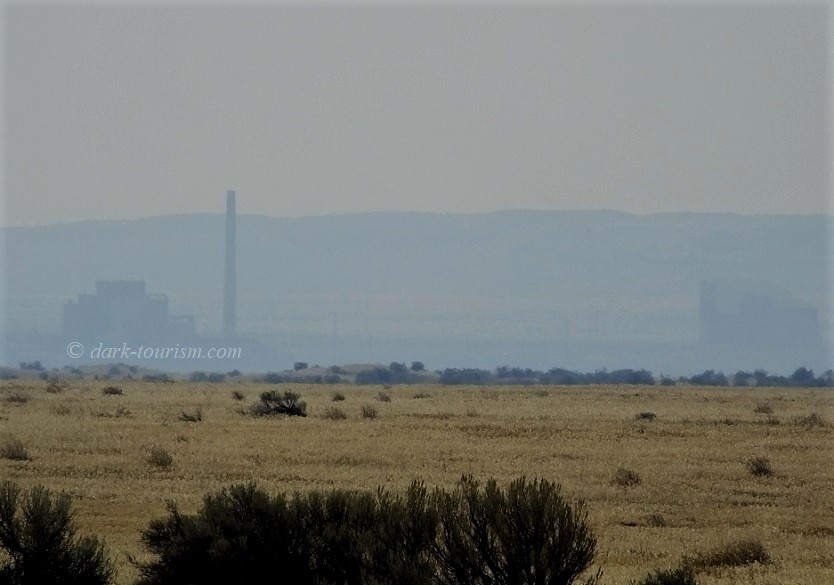
It’s the site where the plutonium for the first atomic bombs came from including that used in the Trinity Test and that dropped on Nagasaki. With regard to the early phases of the Atomic Age, Hanford’s significance can thus hardly be overstated. Over time more and more rectors were installed at Hanford and it’s from here that the majority of the fission material used in the production of the USA’s vast nuclear arsenal came from. The photo above is unfortunately not very good, not just because it was taken from a great distance, but especially because of the haze. This was from wildfires that were raging many miles to the north at the time but still filled the air with this yellow haze. It was quite spooky, really, driving through this yellowness for a good few hours.
In addition to B Reactor on the left you can also see the vague shape of another building, that’s Hanford’s C Reactor. The whole site has meanwhile been decommissioned and most of the other reactors have been dismantled. But B Reactor is being preserved as a National Historic Landmark and a few years ago it was opened to the public, albeit only on restricted guided tours. And at the time I was there, tours were limited to US citizens only. But this restriction has meanwhile been lifted. Maybe I will have to return one day …
Next up is the British equivalent of Hanford, as it were. This is Sellafield in Cumbria:
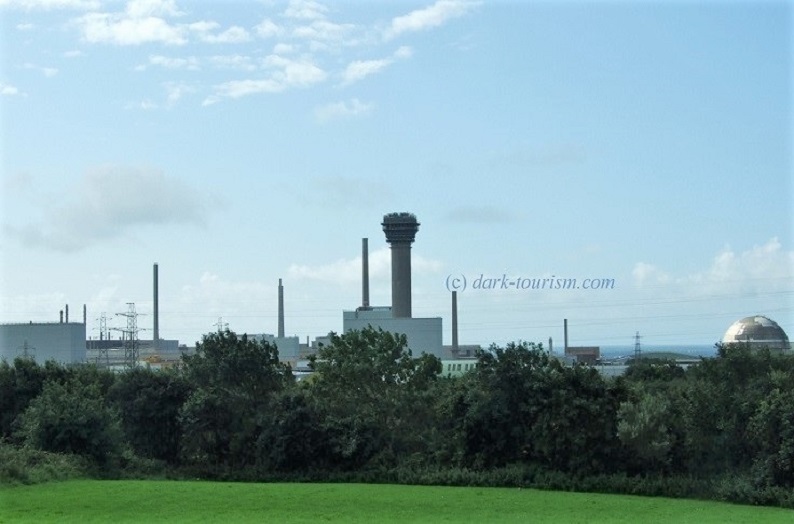
Sellafield is a nuclear site that has also achieved a string of firsts: it was the first site to produce plutonium for the British nuclear arsenal, including the very first British A-bomb. It was also here that the first non-military, commercial reactor started providing electricity to the national grid. … and it was the first such site to experience a serious nuclear accident, namely the Windscale fires of 1957. Windscale was the name of one of the early reactors and in the photo you can see it in the centre, that tall structure towering over everything else. The photo was taken from afar, namely the former visitor centre and exhibition, in 2008. Sadly that closed down many years ago, but there’s a newer exhibition in nearby Whitehaven.
Another NPP that infamously suffered a serious accident with a reactor core meltdown, was the Three Mile Island plant near Harrisburg, Pennsylvania, USA. This is what it looks like today – or rather: in 2010, when this photo was taken:
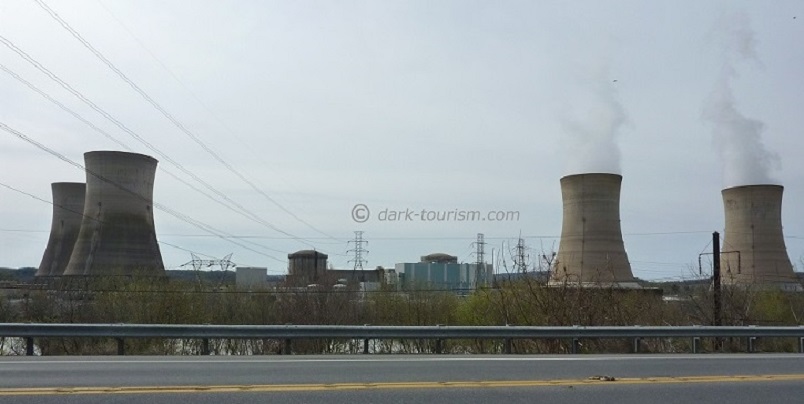
You can see that the pair of cooling towers on the right are active (emitting steam), while those on the left are silent. That’s because the plant had two reactors, and it’s the one on the left where the accident happened back in 1979. That reactor has been shut down and sealed ever since. The other reactor was unaffected and hence remained in operation, until September 2019 that is. Now the site is undergoing decommissioning. As you can see, the photo above was also taken from a good distance away, as the island itself is off limits. I took this photo from the side of the main road going past Three Mile Island, namely where there is a little historical marker plaque. That’s all – the site is not commodified for visitors in any other way.
When you talk of accidents at nuclear power plants, the biggest one, the “Mother of all Nuclear Accidents”, as it were, has to be mentioned: Chernobyl. The accident in April 1986 happened at Block 4 of the NPP, over which a concrete-and-steel “sarcophagus” was hastily constructed that has meanwhile disappeared under an new superstructure, the New Safe Confinement. But instead of a photo of that I give you an image that may look quite familiar if you’ve seen the previous blog post:
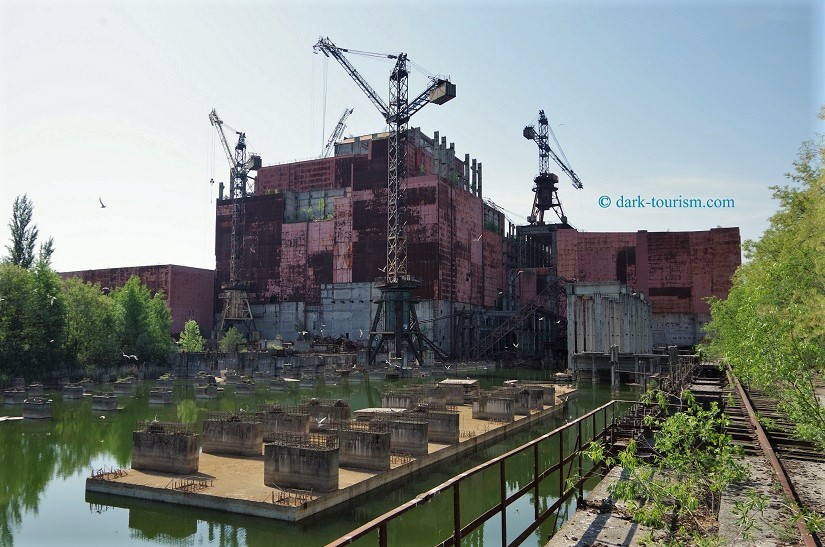
In that post I gave you an image of a reflection of the block and construction cranes in the water in the foundations of what was supposed to become a turbine hall. Last time I visited Chernobyl (in November 2018), I even explored that massive industrial ruin from the inside and climbed all the way to the roof. Nuclear urbexing, as it were. It was fab!
And on my second trip to Chernobyl I went on a tour of the inside of the finished plant and that included a stop at one of the control rooms (of block 2, if I remember correctly):
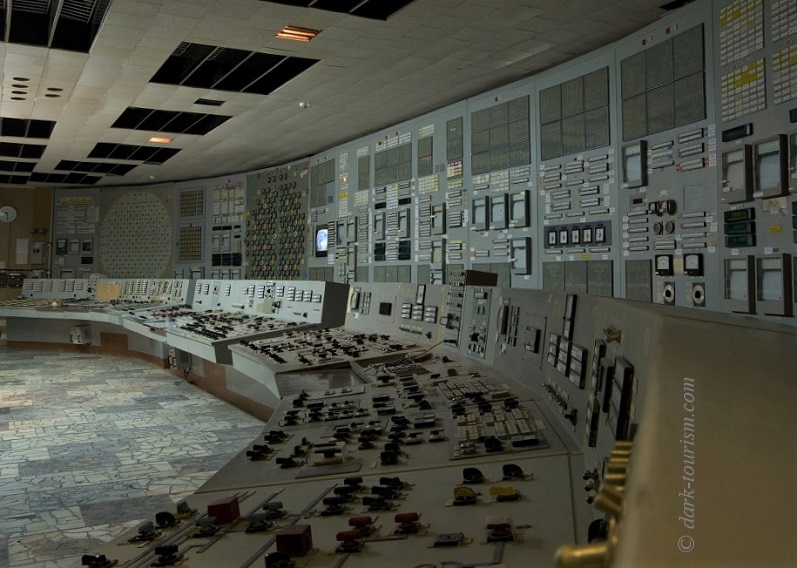
This control room was still partially in use when I was there in 2015, even though the associated reactor had long been shut down, but it’s still used for monitoring some of the decommissioning work.
And when you mention Chernobyl you also have to mention Fukushima, of course, where the second worst nuclear accident ever happened. Here’s a photo of that NPP that has featured on this blog twice before (namely here and here):
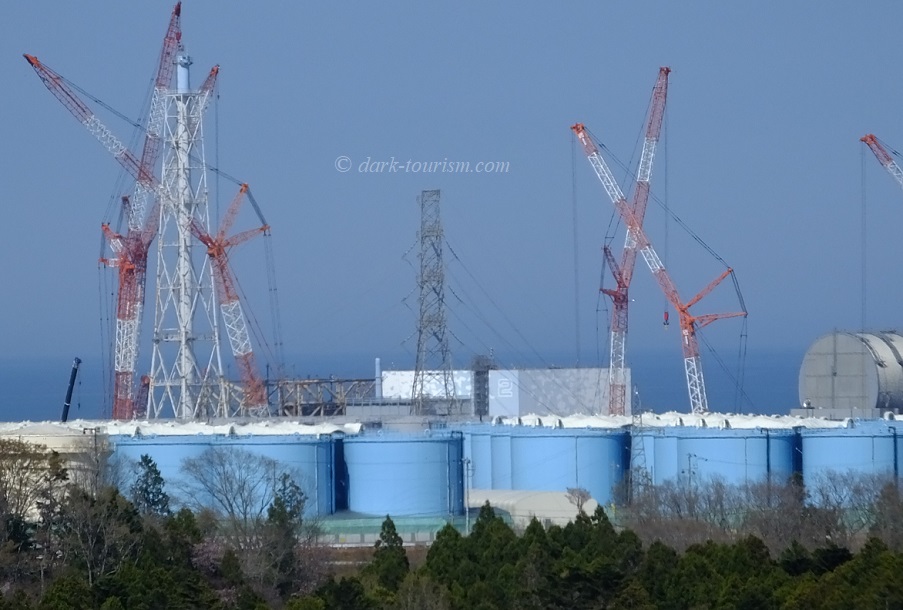
You can see two of the stricken blocks of the March 2011 tsunami-induced triple meltdown and explosions, and in the foreground there are several of the huge cluster of tanks containing tritium-contaminated water, which will soon be released into the ocean despite much controversy. I took this photo from a hillside that is the closest you are allowed to get to the plant as a normal mortal. That was during my two-day Fukushima Tour in April 2019.
Also not to be visited as such but viewable a little bit closer up is this beauty, Dounreay on the north coast of Scotland, Great Britain:
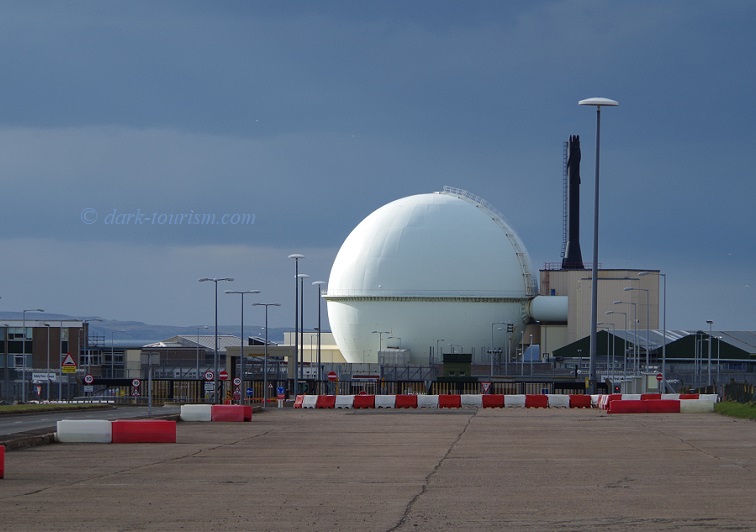
This is also a photo that has featured on this blog before, namely in the themed post “dark tourism & spheres”. The Dounreay fast breeder reactor is contained inside this huge steel globe, which is sometimes referred to tongue-in-cheek as the “golf ball”. This photo was taken from the approach road to the nearby car park which is the official viewing point. That’s as close as you can get to the site, which is also undergoing decommissioning. One of the early reactors’ control room equipment was given to an exhibition in Thurso to the east of Dounreay. And the good news is you will soon be able to visit it again, after two years of closure due to financial issues. The place used to be called “Caithness Horizons” but will reopen next month under the new name “North Coast Visitor Centre” (according to this article – external link).
The only actually working NPP that I’ve ever visited so far was Kozloduy in Bulgaria. But taking photos inside was unfortunately not permitted, so I can, again, only give you a photo I shot from a good distance with a telephoto lens:
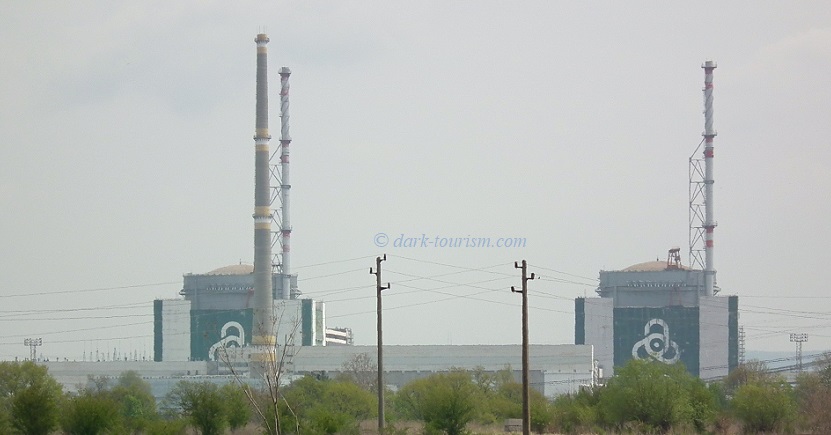
Before our tour of the Kozloduy plant a lot of security clearance was necessary and signing of disclaimers and all that, but in the end we were allowed inside. The highlight was visiting the control room of one of the reactor blocks, staffed and in operation. It was quite calm, even when an alarm sounded. But I was assured that it was just a routine alarm intended to keep staff alert. My visit was shortly after the accident at Fukushima, and when following the NPP tour we proceeded to a nearby independent measuring station and lab, a staff member said they could measure radiation from Fukushima and remarked drily that walking outside in the rain may not be such a good idea at that time (and that was what we had just done: walking to the lab in the rain!). Apparently there was some “incident” or minor accident at the Kozloduy plant in July 2019 (see this account – external link).
In terms of dangerous NPPs, few come close to this one, Metsamor in Armenia:
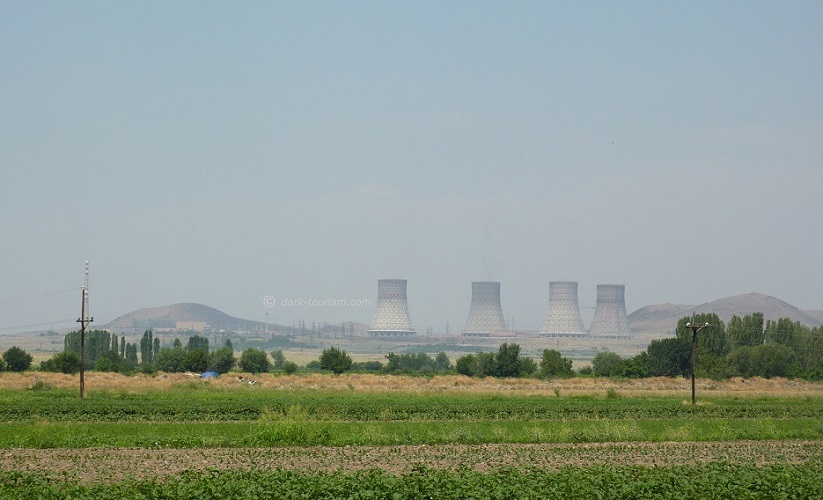
Metsamor is one of last few remaining NPPs that doesn’t feature a containment structure (the other four are in Russia), as was quite common in the Soviet Union at the time when this plant was built back in the 1970s. It is now ageing and probably past its nominal operational lifetime, but as Armenia receives 40% of its electricity from the plant and is cut off from the outside world to the west (Turkey) and east (Azerbaijan) it’s still reliant on Metsamor. The main risk, other than age, is that Armenia is a highly earthquake-prone region, as the deadly 1988 Spitak earthquake demonstrated drastically. In fact, the Soviets initially shut down Metsamor after that disaster, but post-Soviet independent Armenia suffered an energy crisis in the 1990s and so it was decided to reactivate the plant.
At the other end of the danger scale is this squeaky clean NPP, Zwentendorf in Austria:
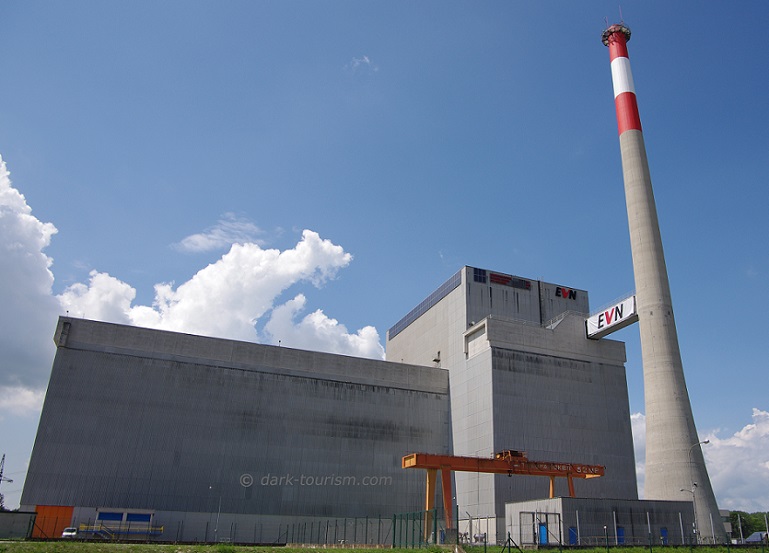
The reason why Zwentendorf is often referred to as “the safest NPP in the world” is because it has never been in operation. By the time construction was completed and the fuel rods were ready to be inserted into the reactor, a referendum about the use of nuclear power had been held in Austria and the narrow result said “No”. So the fuel rods were returned to the (German) manufacturer and the plant has been standing silent and useless ever since. Or not quite so useless. Its reactor may never have generated a single watt of power, but the site is used for safety training of staff from other NPPs of a similar design. It has moreover served as a film set repeatedly. For both purposes Zwentendorf is unique. At no other (active or decommissioned) NPP can you safely walk right into the reactor core and other parts that would normally be out of bounds or would require you to wear special protective clothing.
And in fact because Zwentendorf is so safe, even the general public is allowed in – albeit only on seasonal once-a-week guided tours. Places usually fill up as soon as the season opens, but in 2013 I was lucky to grab a place on a tour when it was a special open day to mark the 35th anniversary of 1978 referendum. On that occasion they had several tours running over the course of the day. On last year’s anniversary I marked this on this blog with this post. There you can find a good few more photos – do take a look. Zwentendorf is immensely photogenic, I hope you’ll agree! (Also check out the website entry’s photo gallery.) So if you’ve been following this blog long enough you will be familiar with this image:
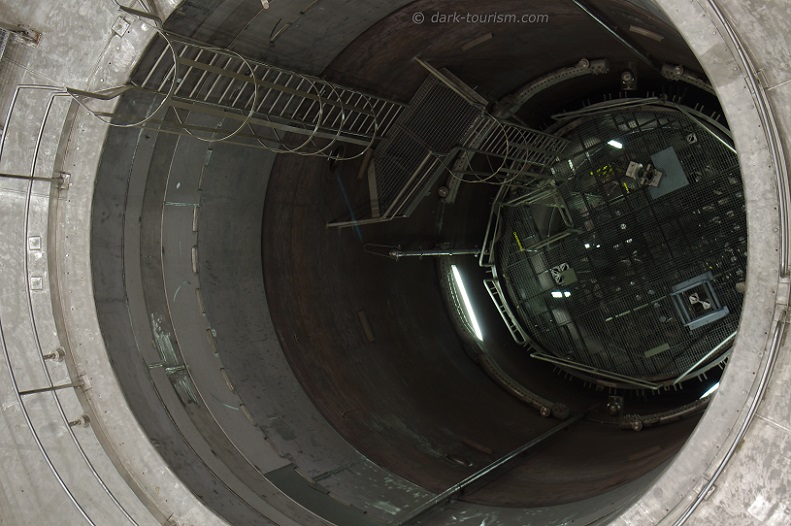
This is a unique view straight into an open reactor core without it being covered with water (to contain the radiation). But since no fuel rods have ever been inserted it’s perfectly safe.
And finally, here’s an NPP that also never started operation, namely Lemoniz in Spain (same photo as the featured one at the top of this post):
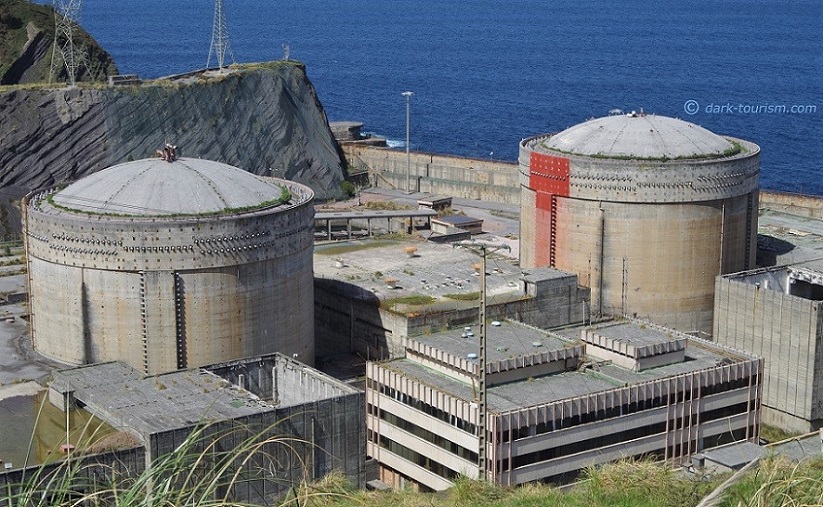
In this case the reasons the plant never went into operation have nothing to do with a general public referendum (Spain did adopt nuclear power in the 1960s and still operates five plants), but are more darkly political in nature. Lemoniz is in the Basque Country, which was heavily opposed to the power plant. The infamous former separatist terror organization ETA repeatedly targeted the plant when it was under construction in the 1970s. They assaulted security personal, managed to smuggle two bombs into the site and set them off causing structural damage, and in 1981 even kidnapped and killed the chief engineer of Lemoniz! ETA lost some support among the general population after that, but Lemoniz was also doomed. After a new left-leaning government came into office in 1983, a general moratorium on new NPPs was passed and construction at Lemoniz halted for good. Now it is just an industrial ruin by the coastal road, from where this photo was taken. The site as such is not accessible for members of the public.
But so much for dark nuclear power plants. Hope you found it interesting.




10 responses
The Beloyarsk Nuclear Power Station is located near the city I live in. I visited it with my students few years ago, and it was really impressive and interesting! But, of course, no photos etc, all these top secret things… I completely understand why these rules exist, but eh anyway…
In school I had a course of basic health and safety, and some lessons were dealing with nuclear safety and security, for example, what we should do in case of different accidents on that kind of plants…
A fun fact – Zarechny (the site of the Beloyarsk nuclear power station) is known by amazing JAWS brewery. Their first brewpub Nuclear Laundry was open in the building of former laundry, it’s very cozy and atmospheric 🙂
Also the notorious Mayak disaster was not so far (in the Russian scale), and all in my city know some urban legends dealing with this accident and its consequences, for example, a story about Alyoshenka the Kyshtym dwarf…
thanks for the comment – very intersting. I’m now wondering what a “Kyshtym dwarf” might look like 😉 And speaking of JAWS, I had a few of their beers when I was last in Russia in 2017. I was totally amazed by the craft beer scene in Russia, even in far-away places like Perm or Volgograd. Top-notch brews and at good prices. On a par with Poland I would say and both better than almost anywhere further west in Europe.
Oh, we like to joke that Alyoshenka was the Ata’s elder brother 🙂 it could be a sad story about two strange siblings on opposite ends of the earth…
But the Alien monument in so called Molebka’s anomalous zone is nicknamed Alyoshenka too, so you can imagine him as you want : D
So glad to hear that you like our Ural beer!
And I want to ask you for a long time. You were in Perm – did you visit Ekaterinburg too?
yes I travelled to Perm to go on a tour to the Perm-36 Gulag site. (And in the city of Perm itself I was happily surprised to find two excellent craft beer bars.)
But I’ve never made it to Ekatarinburg yet. So many places, so little time …
If some day you will visit Russia again, come to Ekaterinburg! We’d be happy to see you here and show you some interesting places in our region, not only related to Nicholas II or the Dyatlov Pass incident…
right now I’m not even sure if I could leave Austria! Germany has just classed us as a high risk region.
For several years, I interpreted for a nuclear regulators group, covering all Europe and former Soviet Union, and so heard reports on the different reactors and their problems. Every meeting finished with a visit to the or one of the host country’s nuclear power plants, but I never got to go on those visits, sadly. I very much wanted to. And so, to date, my only encounter with a nuclear power plant is one in South Korea, which ended up between me and the place I was trying to get to, and after following a dusty highway in near 40-degree heat and realizing the only way out was transport through a very long road tunnel, I sat to wait for the infrequent bus and cursed that coast-hogging nuclear plant.
In Nizhny Novgorod, my neighbour at the student residence was from the closed town where the Mayak disaster happened, and she had lots of stories about things nuclear.
we talked the other day about possibly organizing a group visit to Zwentendorf – would you be interested?
Hello Peter,
You seem to be very active on this forum, so I was wondering if you would be interested in answering a few questions I have about this subject. I am currently writing a term paper for a tourism studies class at my university, and I would like to include some quotes/information from actual tourists.
well it is my forum (blog), so naturally I am the most active one here. For your questions please use this email: contact(at)dark-tourism.com